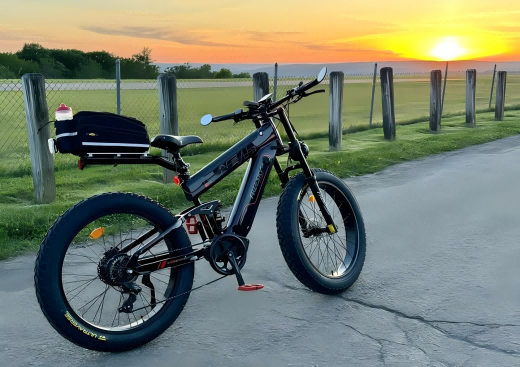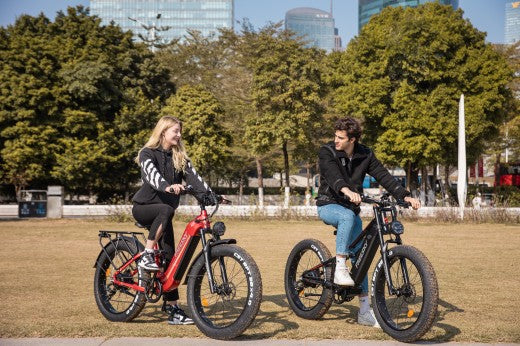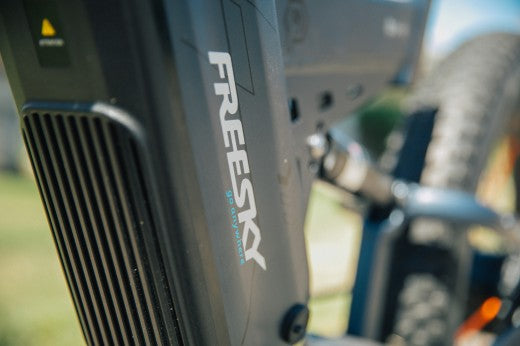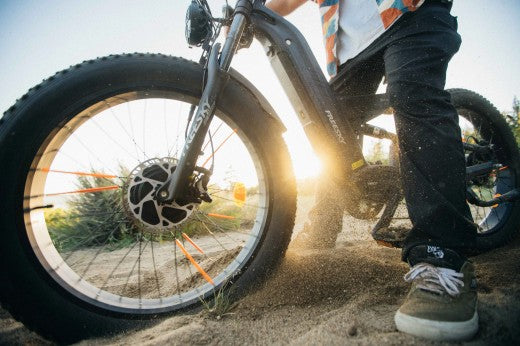FREESKY Blogs
Stay updated with the latest news, tips, and insights on e-bikes, technology, and sustainable riding through the FREESKY blog.
There's no item in your cart.
You May Also Like
You're Saving C$0.00
Shipping, taxes, and discount codes calculated at checkout.All Topics


How to Measure e-Bike Battery Capacity: A Comprehensive Guide
Dec 13, 2024
When it comes to electric bikes (e-bikes), one of the most important factors influencing performance is the battery. Whether you’re a seasoned cyclist or a newbie to the world of e-bikes, understanding how to measure e-bike battery capacity is crucial for optimizing your ride. A bigger capacity means longer rides, more power, and ultimately more fun! But how exactly do you measure that? Let’s dive into it. 1. What Is Battery Capacity? Battery capacity refers to how much energy a battery can store and deliver to power your e-bike. It is typically measured in watt-hours (Wh). The higher the watt-hour rating, the more energy the battery can store, and thus, the longer your ride time will be before needing a recharge. 2. The Formula for Measuring Battery Capacity To calculate the capacity of an e-bike battery, you can use the following simple formula: Battery Capacity (Wh) = Voltage (V) × Amp-Hours (Ah) Voltage (V): This is the electrical potential of the battery. Common e-bike battery voltages are 36V, 48V, or even higher. A higher voltage allows the bike to deliver more power, especially at higher speeds or for tackling steeper hills. Amp-Hours (Ah): This is a measure of how much charge the battery can hold. The higher the amp-hour rating, the longer the battery will last on a single charge. For example, if you have a 48V battery with a capacity of 10Ah: Battery Capacity = 48V × 10Ah = 480Wh This means your battery can supply 480 watts of power for one hour, or less power over a longer period. 3. What Does Battery Capacity Mean for You? Knowing your battery’s capacity helps you understand how far you can ride before needing to recharge. Here’s what you should know: Higher Capacity = Longer Range: A battery with a higher Wh rating will generally provide a longer range. For example, a 500Wh battery could take you between 30 to 50 miles on a single charge, depending on factors like rider weight, terrain, and level of pedal assistance. Battery and Motor Compatibility: A higher voltage battery is typically paired with more powerful motors to deliver better performance, especially on hilly terrain or for riders who want to go faster. 4. Factors That Affect e-Bike Battery Capacity and Performance While battery capacity gives you a basic idea of how far you can go, several factors influence the actual performance: Terrain and Elevation: Riding on flat terrain will drain the battery less quickly than hilly or mountainous terrain. Steep inclines demand more power, shortening your range. Riding Style: If you prefer higher pedal assistance settings or use the throttle more often, your battery will deplete faster. Riding conservatively or using lower power levels will extend battery life. Temperature: Extremely hot or cold weather can negatively impact battery performance. Cold temperatures especially can reduce a battery's range. Rider Weight: A heavier rider will require more energy to move the bike, thus reducing the overall range. 5. How to Extend the Life of Your e-Bike Battery Understanding your e-bike’s battery capacity is just the first step. To maximize the performance and lifespan of your battery, consider these tips: Avoid Completely Discharging Your Battery: Try to recharge your battery before it reaches 0%. Keeping it between 20% and 80% charged is ideal for maintaining its health. Store Your Battery Properly: If you're not using your e-bike for a while, store the battery in a cool, dry place. Extreme temperatures can cause long-term damage to the battery. Use Your Battery Efficiently: Pedal more to conserve battery power, especially on flat terrain or downhill stretches. The more you rely on pedaling, the less you’ll rely on the motor, which helps conserve battery. 6. Choosing the Right Battery for Your e-Bike When shopping for an e-bike or considering a battery upgrade, understanding battery capacity helps you make an informed decision. Choose a battery with the appropriate voltage and amp-hour rating that suits your riding habits and terrain. If you plan on taking long rides or tackling steep hills, you’ll need a higher capacity battery. On the other hand, if you stick to flat terrain and shorter trips, a lower capacity battery could suffice. 7. Conclusion: Battery Capacity = More Freedom Understanding how to measure e-bike battery capacity allows you to make the most of your e-bike experience. Whether you’re looking for a longer range, more power, or simply trying to figure out how much ride time you have left, knowing your battery capacity and the factors that influence it will help you get the most out of your e-bike. Always choose the battery size that matches your riding style, and follow proper care and charging practices to ensure your battery performs optimally for years to come. Ready to ride further and smarter? Know your battery, and enjoy the freedom that comes with it!
Read More

Commuting in Winter? The Ultimate Guide to Safe and Cozy eBike Rides
Dec 09, 2024
As the winter chill settles in, commuting on your eBike can seem daunting. However, with the right preparation, your electric bike can still be an excellent way to get around, even in the colder months. Whether you're a seasoned eBike commuter or new to the winter cycling scene, this guide will help you stay safe and comfortable while enjoying your winter rides. 1. Dress for the Weather: Layer Up! When commuting in cold weather, layering is key. Start with moisture-wicking base layers to keep sweat away from your skin. Avoid cotton, as it absorbs moisture and can make you feel colder. Instead, opt for synthetic or merino wool fabrics that will keep you dry and warm. Next, add an insulating layer, like a fleece or down jacket, and finish with a windproof and waterproof outer layer. Don’t forget gloves, thermal socks, and a good winter cycling hat or helmet liner. Consider investing in heated gloves or heated insoles if you'll be riding for long periods. 2. Winter Tires: Grip and Safety When the roads get icy and slippery, your standard eBike tires may not provide the traction you need. Consider upgrading to winter-specific tires. These tires have deeper treads and a rubber compound that stays flexible in cold temperatures, offering improved grip on snow and ice. Studded tires are another excellent option for areas with frequent ice patches, as they provide extra traction by digging into the ice. Make sure to adjust your tire pressure as well—slightly lower pressure can increase the surface contact, helping you maintain stability on slick surfaces. 3. Light Up the Road: Visibility is Crucial Winter days are shorter, meaning you'll likely be riding in low light conditions more often. Make sure your eBike is equipped with high-quality front and rear lights. A bright, visible front light will help you see the road ahead, while a blinking red rear light will alert other road users to your presence. Additionally, reflective clothing or accessories, like vests, ankle straps, or reflective decals on your bike, can help you stand out even in foggy or snowy conditions. 4. Keep Your eBike Clean and Dry Winter weather can be tough on your eBike, so regular maintenance is essential. Salt, grime, and moisture can build up quickly and cause rust and corrosion. After each ride, make it a habit to wipe down your bike, especially the frame, wheels, and motor areas. Invest in a chain cleaner and oil to keep your drivetrain running smoothly. A bike cover or storage shed is also a good idea to protect your bike from the elements when it's not in use. 5. Check Your Battery: Cold Weather Challenges Cold temperatures can have an impact on your eBike’s battery performance. In freezing conditions, battery life may be reduced, and recharging times may take longer. To mitigate this, try to store your battery indoors when it's not in use, and keep it warm while commuting by carrying it in a bag or using a battery cover. Before heading out, ensure your battery is fully charged and check the manufacturer’s recommendations for winter usage. If your battery feels sluggish, consider investing in a high-performance winter battery that is better equipped to handle the cold. 6. Slow and Steady Wins the Race Winter roads can be unpredictable, so it’s essential to ride with caution. Snow, ice, and even wet leaves can make the road slippery, so always reduce your speed when conditions are less than ideal. Try to maintain a steady pace and avoid sudden stops or sharp turns, as they can cause your wheels to slip. Using the pedal-assist mode can be helpful in winter conditions, as it gives you more control over your speed and balance, making it easier to navigate tricky spots. Remember, winter biking requires more focus and patience, so take your time to reach your destination safely. 7. Essential Gear for Cold Weather Rides Besides the obvious clothing layers, there are a few other pieces of gear that can improve your comfort and safety while winter commuting: Fenders: These will help keep snow, slush, and dirt off your bike and your clothing. Bike Lock: Cold weather means fewer people are outside, so your bike might be more vulnerable to theft. Consider using a heavy-duty lock. Hand Warmers: Keep a pair of disposable or reusable hand warmers in your pockets for those extra-cold days. Weather-Resistant Panniers or Backpack: Keep your belongings dry and protected from snow and rain. 8. Plan Your Route: Choose the Right Roads If possible, try to plan your winter routes on roads that are frequently plowed or treated with salt. Avoid paths that might become ice-covered or poorly maintained during heavy snowfalls. Many cities have designated bike lanes, so check if there are any winter-specific biking paths available in your area. Make sure to give yourself plenty of time for your commute, as winter weather can cause delays due to slower traffic or icy conditions. 9. Stay Safe: Know When to Stay Inside Sometimes, the weather can be too extreme to bike safely. Snowstorms, freezing rain, or sub-zero temperatures can be hazardous, and it’s okay to opt for alternative transportation when conditions are unsafe. Check the forecast before heading out and be aware of changing weather patterns during your ride. If you're uncertain about your abilities in the snow or ice, consider taking a short test ride in a safe area to assess how your eBike performs. Always prioritize safety, even if it means adjusting your plans.
Read More

How to Maximize Your Ebike’s Lifespan?
Nov 29, 2024
Electric bikes (eBikes) are an investment in both convenience and sustainability, but like any technology, they require proper care to maximize their lifespan. By following a few key practices, you can ensure that your eBike remains in top condition, delivering reliable performance for years to come. Here’s how to keep your eBike running smoothly: 1. Regular Maintenance is Key Routine maintenance goes a long way in extending the life of your eBike. Treat your bike like a car—regular check-ups can prevent small issues from turning into big problems. Check the tires: Inspect them for wear, cracks, or punctures. Proper tire pressure helps reduce strain on the motor and battery. Lubricate the chain and gears: Regular lubrication helps prevent rust and ensures smooth shifting. Tighten bolts and screws: Vibration from riding can loosen components over time. Make sure everything is secure before each ride. 2. Store Your eBike Properly Storing your eBike in the right conditions is just as important as using it properly. Avoid extreme temperatures: Both very hot and very cold temperatures can affect your battery and other components. Store your bike in a cool, dry place. Keep it covered: When storing your eBike outdoors, use a weather-resistant cover to protect it from the elements. Avoid prolonged exposure to moisture: If you ride in the rain, be sure to dry your bike off afterward, especially the motor and electrical components. 3. Battery Care is Crucial The battery is the heart of your eBike, and taking care of it is essential to maximizing its lifespan. Charge properly: Avoid overcharging or letting the battery drain completely. Aim to charge it when it hits around 20-30% capacity and unplug it once it’s fully charged. Store the battery correctly: If you're not using your eBike for an extended period, remove the battery and store it in a cool, dry place. Avoid deep discharges: Frequent deep discharges can shorten the lifespan of your battery. Try to keep it within a moderate charge range, typically between 30% and 80%. 4. Ride Smart How you ride your eBike can impact its longevity. Avoid excessive speed: Riding too fast for extended periods can strain the motor and battery. Use eco or pedal assist mode when possible. Don’t overload your bike: Carrying too much weight can strain the motor and other components. Stick to the manufacturer’s recommended weight limit. Pace yourself on tough terrain: Riding on steep hills or uneven surfaces can put extra strain on your eBike. Take it easy on tough trails to prevent overloading the motor. 5. Perform Regular Inspections Your eBike's components will wear over time, so it's important to inspect them regularly. Check the brakes: Make sure the brake pads are not worn down, and test the brake cables to ensure they are working properly. Inspect the electrical system: Look for any exposed wires or loose connections. If you notice anything unusual, have a professional check it out. Monitor the motor: If you notice any unusual noises or performance issues with the motor, it may need servicing. 6. Upgrade When Necessary eBikes are built with replaceable parts, so don’t hesitate to replace components that are no longer performing well. Motor upgrades: If your motor starts showing signs of wear, consider upgrading it to a more powerful or efficient version. Battery replacements: Batteries eventually lose their ability to hold a charge. If you notice a significant drop in range, it may be time to replace the battery. 7. Get Professional Servicing While you can perform routine maintenance yourself, it’s a good idea to have your eBike professionally serviced at least once a year. A trained technician can spot potential issues before they become serious, helping to extend the life of your bike. Conclusion Maximizing the lifespan of your eBike requires a combination of routine maintenance, careful riding habits, and proper storage. By following these simple tips, you’ll ensure your eBike remains reliable, efficient, and enjoyable for years to come. Whether you’re commuting, exercising, or just enjoying a leisurely ride, proper care is key to keeping your eBike in optimal condition!
Read More

How to Protect Your eBike Battery in Winter: Essential Tips
Nov 26, 2024
As winter sets in, many eBike owners face the challenge of maintaining battery performance in cold weather. Batteries are one of the most important components of an electric bike, and their efficiency can be significantly impacted by low temperatures. To keep your eBike running smoothly throughout the colder months, here are some essential tips on how to protect your eBike battery in winter. 1. Store Your Battery in a Warm Place One of the most effective ways to protect your eBike battery during winter is to store it in a warm environment. Cold temperatures can cause the battery to lose charge more quickly, and extreme cold can even damage the cells. If possible, bring the battery indoors when you're not using it. Storing it at room temperature will help maintain its charge and prolong its lifespan. If storing the entire bike inside is not feasible, always remove the battery and store it separately. 2. Avoid Charging in Extremely Cold Temperatures Charging a battery in freezing conditions can be harmful and may even cause it to fail prematurely. Before plugging in your eBike to charge, ensure that the battery has reached a more moderate temperature. Ideally, wait for the battery to warm up to at least 32°F (0°C) before charging. Charging when it's too cold can lead to irreversible damage, as lithium-ion batteries are sensitive to extreme temperatures. 3. Keep the Battery Clean and Dry Winter roads often bring a lot of moisture and dirt, which can lead to corrosion or water damage if the battery terminals are exposed. Regularly clean the battery and its connectors using a dry cloth. Avoid using any water or cleaning agents that might damage the battery. Keeping the battery dry is key to maintaining its functionality, especially in wet, snowy conditions. 4. Avoid Letting the Battery Fully Discharge In winter, the cold can drain your eBike battery faster than usual. To prevent running out of charge unexpectedly, avoid letting the battery discharge completely. It’s recommended to recharge the battery when it reaches around 20-30% to ensure it stays in good condition. This practice helps maintain a steady charge and prevents the battery from freezing or becoming overworked. 5. Use a Battery Insulation Cover If you live in an area with extremely cold winters, consider using a battery insulation cover. These covers are designed to help keep the battery warm, ensuring it stays at a more optimal temperature for performance. Insulated covers are especially useful when you need to store your eBike outside or in a garage that may not be heated. Many of these covers are weatherproof and lightweight, making them easy to install and remove when necessary. 6. Monitor Battery Health Throughout the winter, keep an eye on your battery's performance. If you notice any unusual behavior, such as a significantly reduced range or longer charging times, it may be a sign that your battery is struggling to cope with the cold. Regular monitoring helps you catch potential issues early before they become more severe. 7. Ride Smart in Winter Conditions While it's important to protect your eBike battery, it's equally important to ride smart in winter. Cold weather can reduce the efficiency of your bike's motor, which in turn may put additional stress on the battery. Opt for smoother, shorter rides when possible to avoid overtaxing the battery. If snow or ice is present, be cautious of slippery surfaces to avoid sudden power demands from the motor, which could cause the battery to drain faster. Conclusion Winter doesn’t have to mean the end of your eBike riding season. By taking a few simple precautions to protect your battery, you can enjoy your electric bike throughout the colder months without compromising its performance. Store your battery in a warm place, avoid charging in freezing conditions, and keep the battery clean and dry. And don’t forget to monitor its health and adjust your riding habits to conserve battery life. With these steps, you'll ensure that your eBike battery remains in optimal condition, no matter the weather outside!
Read More

How to Maintain eBike Tires: A Complete Guide
Nov 18, 2024
Proper tire maintenance is crucial for keeping your eBike running smoothly and ensuring your safety on the road. Neglecting tire care can lead to decreased performance, reduced range, and even accidents. Here’s a complete guide to help you maintain your eBike tires like a pro. 1. Regularly Check Tire Pressure Proper tire pressure is essential for performance and safety. Why it matters: Overinflated tires can reduce grip, while underinflated ones increase rolling resistance and risk punctures. How to check: Use a tire pressure gauge to measure the PSI (pounds per square inch). Refer to the recommended pressure range printed on the tire sidewall. Tip: Check pressure at least once a week, especially before long rides. 2. Inspect for Damage and Wear eBike tires endure more strain than regular bike tires due to higher speeds and weight. What to look for: Cracks or cuts in the rubber. Bulges or uneven wear. Exposed threads indicating the tire is worn out. Solution: Replace damaged or worn tires immediately to avoid blowouts. 3. Keep Tires Clean Mud, debris, and road grime can degrade tire material over time. How to clean: Use a soft brush or cloth to remove dirt. Wash with mild soap and water, avoiding harsh chemicals. Dry thoroughly to prevent moisture damage. 4. Rotate Your Tires If your eBike allows it, rotate the tires to ensure even wear. Why it’s important: The rear tire often wears out faster due to higher load and traction demands. When to rotate: Every few months or after about 1,000 miles of use. 5. Protect Against Punctures Punctures can ruin your ride, but you can take steps to prevent them. Tips: Use puncture-resistant tires or add tire liners. Consider tubeless tires with sealant for added protection. Avoid riding over sharp objects or rough terrain whenever possible. 6. Adjust for Seasonal Changes Temperature affects tire performance, so adjust maintenance accordingly. In winter: Check pressure more frequently, as cold air reduces PSI. Use winter-specific tires if riding in icy or snowy conditions. In summer: Watch for overheating, which can cause overinflation. 7. Tighten Tire Bolts and Axles Loose bolts or axles can lead to misalignment and uneven tire wear. How to check: Ensure all bolts and axles are secure, but avoid overtightening, which can cause damage. 8. Replace Tires When Needed Even with the best care, tires won’t last forever. Signs it’s time to replace: Tread is completely worn out. Frequent flats or slow leaks. Tires are over three years old, as rubber can degrade over time. Final Thoughts Taking care of your eBike tires doesn’t have to be complicated. With regular checks, proper cleaning, and timely replacements, you can enjoy a smooth and safe ride every time. Remember, well-maintained tires not only extend your eBike’s lifespan but also enhance your riding experience. Stay safe and happy riding!
Read More

E-Bike vs. E-Scooter: Find the Perfect Ride for Your Commute
Nov 07, 2024
When it comes to urban commuting or leisurely weekend rides, both e-bikes and e-scooters offer convenient, eco-friendly alternatives to traditional transportation. But how do you choose the right option for your needs? Whether you’re looking for a versatile commuting tool or something to cruise around the city, understanding the key differences between e-bikes and e-scooters can help you make the right decision. 1. Speed & Range: Getting There Faster E-Bike: With speeds of 20-28 mph (depending on local regulations), e-bikes offer the flexibility of both electric assist and pedal power. Ideal for longer trips, an e-bike typically provides a range of 20-50 miles on a single charge, depending on the model, terrain, and rider input. E-Scooter: E-scooters usually have a top speed of 15-20 mph, which makes them perfect for quick, urban commutes. Their range typically falls between 10-30 miles, depending on factors like battery capacity, rider weight, and the type of roads you’re traveling. 2. Comfort & Ride Quality: Smooth or Bumpy? E-Bike: Thanks to their larger tires and padded seats, e-bikes offer a more comfortable ride, especially on longer distances and uneven surfaces. Some models also feature suspension systems for added comfort, making them ideal for varied terrain. E-Scooter: While e-scooters are more compact and agile, they typically have smaller wheels and no suspension, making them less comfortable over bumpy roads. They’re best suited for short, smooth urban rides. 3. Portability: Easy to Store and Transport E-Bike: E-bikes can be heavy, often weighing 40-70 pounds, which can make them cumbersome to carry or store. Some folding models exist, but they’re still bulkier than scooters. E-Scooter: E-scooters are lightweight (typically between 20-40 pounds) and easy to fold, making them highly portable. They can fit into the trunk of a car or be carried up stairs with little effort. 4. Cost: What’s the Price of Freedom? E-Bike: Generally, e-bikes are more expensive, with prices ranging from $1,000 to $5,000 or more for premium models. However, they offer better long-term value due to their versatility and ability to tackle a variety of terrains. E-Scooter: E-scooters are more affordable, typically ranging from $300 to $1,500, depending on the model and features. They’re a great entry point for those looking for an electric vehicle but don’t want to break the bank. 5. Maintenance: Keeping Things Running Smoothly E-Bike: E-bikes require regular maintenance of the motor, battery, brakes, and gears, much like a traditional bicycle. However, their more complex components may require more frequent servicing than a scooter. E-Scooter: E-scooters generally have fewer components that need maintenance, with the main focus being on the battery, tires, and brakes. They’re easier to maintain but may need more frequent tire replacements due to the small wheel size. 6. Safety: Which Is Safer for Your Ride? E-Bike: Due to their higher speeds and the ability to go off-road, e-bikes may be safer for longer trips if equipped with proper safety features like lights, reflectors, and a helmet. The added stability of two wheels and the ability to brake effectively also contribute to safer riding. E-Scooter: E-scooters tend to be more precarious because of their smaller wheels and lack of balance. They are best suited for shorter trips, and wearing a helmet is highly recommended. Many scooters now come with features like lights, but they are generally less safe on rougher terrain. 7. Ideal Use Cases: What’s Your Purpose? E-Bike: If you plan to use it for commuting longer distances, tackling various terrains, or carrying cargo, an e-bike is likely the better option. They are also great for those looking to exercise while commuting, as you can pedal as much or as little as you like. E-Scooter: E-scooters are perfect for short urban commutes, running errands around town, or as an accessory to public transportation. They’re also great for riders who need something portable and easy to store. Final Thoughts: E-Bike or E-Scooter? Choosing between an e-bike and an e-scooter ultimately comes down to your needs, budget, and lifestyle. If you’re after long-range commutes, more comfort, and versatility, an e-bike is the way to go. However, if you’re looking for an affordable, compact, and quick solution for short trips around town, an e-scooter might be the better fit. Whichever you choose, both e-bikes and e-scooters are fun, eco-friendly ways to explore your city while reducing your carbon footprint.
Read More

Mastering Your First Ride: A Beginner’s Guide to Electric Bikes
Nov 06, 2024
Are you ready to experience the thrill of riding an electric bike (eBike)? Whether you’re an experienced cyclist or a complete beginner, getting started with an eBike is easy and fun. In this guide, we'll walk you through everything you need to know to ride your eBike safely and confidently. 1. Understand Your eBike Components Before hitting the road, it's essential to get familiar with the main components of your eBike: Battery: Provides the power for your eBike to move. It’s typically located on the frame or rear rack. Motor: The heart of your eBike, it helps you pedal with less effort by providing an extra boost. Motors are usually located in the rear wheel hub, mid-drive system, or front wheel hub. Pedal Assist System (PAS): Allows you to control how much assistance you get from the motor as you pedal. You can usually adjust the level of assist via the bike’s display or control panel. Throttle (if applicable): Some eBikes come with a throttle that allows you to accelerate without pedaling. The throttle is typically located on the right handlebar. Brakes: Like any bike, eBikes come equipped with brakes. Learn how your eBike's brakes work before setting off, especially if you’re new to cycling. Display: Your eBike will likely have a display screen that shows battery life, speed, distance traveled, and other important data. 2. Get Comfortable with the Basics Before taking your eBike on a long ride, it’s important to get used to its power and handling. Here’s what you should do: Check the battery: Ensure the battery is fully charged before you head out. Adjust the seat: Make sure your seat height is comfortable, with a slight bend in your knees when your foot is at the lowest point of the pedal stroke. Check tire pressure: Proper tire pressure is essential for safe and smooth riding. 3. Start with Low Pedal Assist When you’re just starting, it’s a good idea to use a lower level of pedal assist to get a feel for the bike. This allows you to pedal normally and get accustomed to the extra boost from the motor. 4. Use the Throttle (If Available) If your eBike has a throttle, start by gently twisting the throttle to accelerate. Practice using it in a controlled environment (like a parking lot or quiet street) before using it in traffic. Be sure to go easy on the throttle until you feel comfortable with the bike’s speed. 5. Practice Braking Take some time to practice braking smoothly. Your eBike’s motor can help slow you down, but you’ll still need to use the brake levers. Apply the brakes gradually and avoid sudden, sharp braking to prevent accidents. Front brake: Use the front brake gently, especially when riding at higher speeds, to avoid tipping forward. Rear brake: Use the rear brake in combination with the front brake for more control. 6. Ride in Different Environments Once you feel comfortable with your eBike in a controlled setting, it’s time to test it in different environments: Flat Roads: Practice on flat, smooth roads to get a feel for your bike’s speed and handling. Hills: Your eBike is great for tackling hills. Use a higher level of pedal assist to help you power up inclines. Remember, the motor will do most of the work, but you’ll still need to pedal. Downhill: On downhill sections, you can let the motor assist you with braking, but be cautious and always keep both hands on the handlebars. 7. Stay Safe Wear a helmet: Safety should always come first. Make sure you wear a helmet that fits properly. Follow the rules of the road: eBikes are subject to the same rules as regular bicycles. Be mindful of traffic laws and signals, especially if you’re riding in busy areas. Stay visible: Wear bright clothing, use bike lights, and signal when turning to make yourself visible to others. 8. Get the Most Out of Your eBike As you become more confident on your eBike, here are a few tips to maximize your experience: Manage your battery: Keep an eye on the battery level, especially on longer rides. If you’re running low, switch to a lower pedal assist setting to conserve energy. Maintain your eBike: Regular maintenance, including tire checks, brake inspections, and battery care, will ensure your eBike runs smoothly for years to come. Conclusion Riding an electric bike for the first time can be exhilarating and rewarding. With the right knowledge and a little practice, you’ll be cruising around like a pro. Whether you're commuting to work, exploring new places, or simply enjoying a fun ride, eBikes offer a unique and eco-friendly way to travel. So, get out there, start pedaling, and enjoy the ride!
Read More

Stay Safe on the Road: Decoding Bike Lane Types for Cyclists
Oct 31, 2024
Cycling is a fantastic way to stay active, enjoy the outdoors, and reduce your carbon footprint. However, navigating urban environments can be challenging, especially when it comes to understanding different types of bike lanes. Knowing how to use them safely is key to having a smooth ride. Let’s explore the various types of bike lanes you might encounter and tips for safe cycling. 1. Dedicated Bike Lanes Dedicated bike lanes are physically separated from motor vehicle traffic, often by a curb or a barrier. These lanes offer the safest option for cyclists, as they minimize the risk of collisions with cars. When using dedicated bike lanes: Stay Alert: Keep an eye out for pedestrians, particularly at intersections. Signal Your Turns: Use hand signals to indicate your intentions to others. 2. Buffered Bike Lanes Buffered bike lanes provide a wider lane with extra space between cyclists and motor vehicles. This buffer zone helps to increase safety and comfort for riders. To navigate buffered lanes: Use the Full Lane: Don’t hesitate to take up space if it feels safer, especially in heavy traffic. Be Mindful of Door Zones: Watch out for parked cars and the possibility of doors opening unexpectedly. 3. Shared Lane Markings (Sharrows) Shared lane markings, or sharrows, indicate that cyclists and vehicles should share the road. These lanes are often found on streets without enough space for dedicated bike lanes. When cycling in sharrows: Position Yourself Correctly: Ride in the center of the lane to avoid being squeezed by cars. Be Defensive: Always be aware of your surroundings and be prepared to react to unpredictable traffic. 4. Cycle Tracks Cycle tracks are bike lanes that are elevated or set apart from both traffic and sidewalks. They often have their own signals at intersections. For safe riding in cycle tracks: Obey Traffic Signals: Always follow the specific traffic lights for cyclists. Watch for Pedestrians: Be cautious at crosswalks, where pedestrians may have the right of way. 5. Multi-Use Paths Multi-use paths are wide paths that accommodate cyclists, pedestrians, and sometimes other vehicles. These paths can be found in parks or along waterways. When using multi-use paths: Yield to Pedestrians: Always give priority to walkers and joggers. Communicate Clearly: Use your voice or a bell to alert others of your presence when passing. Conclusion Understanding the different types of bike lanes can enhance your cycling experience and ensure your safety on the road. Always be mindful of your surroundings, signal your intentions, and respect other road users. By being informed and cautious, you can enjoy the many benefits of cycling while contributing to a safer community for everyone. Happy cycling!
Read More

eBike Essentials: Find the Perfect Type for Your Cycling Adventures
Oct 28, 2024
Electric bicycles, or eBikes, have surged in popularity, transforming how we commute and explore our surroundings. With various types available, choosing the right one can be overwhelming. This buyer's guide will break down the main categories of eBikes, helping you find the perfect fit for your riding style and needs. 1. City/Commuter eBikes City eBikes are designed for urban environments, prioritizing comfort and practicality. They often feature: Step-through frames for easy mounting and dismounting. Integrated lights and fenders for safety and convenience. Rack compatibility for carrying groceries or work essentials. These bikes are ideal for daily commuting, providing a smooth and efficient ride through city streets. 2. Mountain eBikes For the adventurous rider, mountain eBikes (or eMTBs) are built for rough terrain. Key features include: Robust frames that can withstand rugged trails. Advanced suspension systems for enhanced shock absorption. All-terrain tires that offer grip and stability on various surfaces. Mountain eBikes empower cyclists to tackle challenging trails while minimizing the effort needed to conquer steep inclines. 3. Road eBikes If speed is your priority, road eBikes are lightweight and aerodynamically designed for efficient long-distance riding. Features include: Slim frames made from materials like carbon fiber or aluminum. Narrow tires that reduce rolling resistance. Higher top speeds thanks to powerful motors. These bikes are perfect for fitness enthusiasts and those looking to cover more ground quickly. 4. Folding eBikes Folding eBikes combine convenience with portability. They are ideal for commuters who need to store their bike in tight spaces or carry it on public transport. Notable features include: Compact design that allows the bike to be folded for easy storage. Lightweight materials for easy handling. Versatile riding options for short commutes or leisurely rides. Folding eBikes offer flexibility for urban riders who want to maximize their travel options. 5. Cargo eBikes Cargo eBikes are built for carrying heavy loads, making them perfect for families or small businesses. Key characteristics include: Sturdy frames designed to handle extra weight. Extended cargo areas either on the front or rear of the bike. Powerful motors to assist with heavier loads. These bikes can replace cars for short trips, making them a practical choice for eco-conscious individuals. 6. Hybrid eBikes Hybrid eBikes combine features from both city and mountain eBikes, making them versatile for various terrains. They typically offer: Comfortable seating positions for relaxed riding. Wide tires for stability on different surfaces. Robust features suitable for commuting or light off-road adventures. These bikes are perfect for riders who want a bit of everything and enjoy exploring diverse routes. Conclusion When selecting an eBike, consider your primary use case, riding style, and comfort preferences. Whether you're commuting through the city, tackling mountain trails, or hauling groceries, there's an eBike that meets your needs. Take the time to test ride different models, and you’ll soon find the perfect electric bicycle to enhance your cycling experience. Happy riding!
Read More